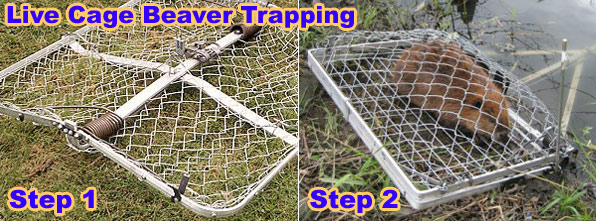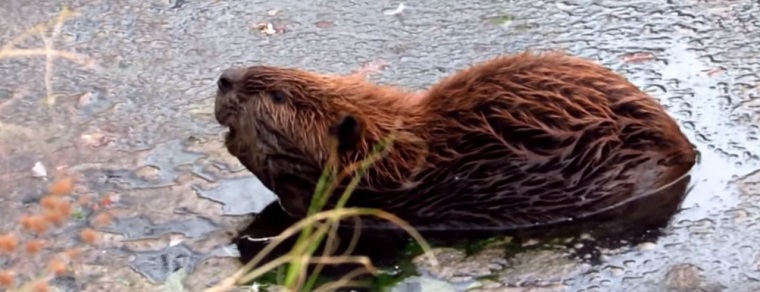-
info@aaanimalcontrol.com
Call us for help in your town
Humane Wildlife Education
How To Get Rid of Beavers
We are experts in beaver control methods, having performed thousands of beaver trapping and removal jobs nationwide.
 Biology: The beaver is the largest rodent found in North America. Adults can weigh up to 65 pounds
and measure from 24 to 36 inches, plus a tail of 12 to 18 inches. With its webbed hind feet,
waterproof fur, and unique paddle-shaped tail, the beaver is well-adapted to living in an aquatic environment. Beavers
constitute a major nuisance species in many parts of the country, particularly the more northern states, where the population is coming back.
Biology: The beaver is the largest rodent found in North America. Adults can weigh up to 65 pounds
and measure from 24 to 36 inches, plus a tail of 12 to 18 inches. With its webbed hind feet,
waterproof fur, and unique paddle-shaped tail, the beaver is well-adapted to living in an aquatic environment. Beavers
constitute a major nuisance species in many parts of the country, particularly the more northern states, where the population is coming back.
Read below for much more detail. You may be able to solve your beaver problem yourself. If you need to hire professional help, you may want to find out what we typically charge for beaver
removal. Pro help is most relevant if you are unable to effectively or legally trap and relocate animals, or if you have a difficult case. If you need beaver removal in your hometown, we
service over 500 USA locations! Click here to hire us in your town and check our prices - updated for year 2020.
Nuisance Concerns:
Beavers are considered a nuisance for two primary reasons: tree cutting and dam building. Tree cutting
is undesirable to landowners who want to protect their trees. Dam building is a more serious matter,
resulting in flooding forest and farm lands, plugged culverts and the washout of roads. In addition, the dam can
threaten downstream property. Some farmers or homeowners have a problem with flooding of trees or crops, flooding of homes,
flooding of highways or railroads, impairment of drainage systems and contamination of water supplies.
Beaver Trapping: There are several types of beaver traps, both live traps and lethal traps. If the animal is live-caught, it
must be relocated at least ten miles from the capture site, and not within the same water system.

Wondering how to get rid of beavers quickly and easily? There is no magic spray or device that you can use to make them go away. Some people
try to sell predator urine, such as coyote or fox urine to get rid of beavers, but that doesn't work. They also try to sell
ultrasonic sound emitters. These devices are worthless at eliminating beavers. Some old wives' tales recommend the use of
mothballs or ammonia-soaked rags to make them leave, but I've been to countless properties where these techniques failed - biologists
know that these attempts won't work. The ONE AND ONLY WAY to take care of your problem is with trapping and removal of the animals.
If you need to find a professional trapper in your hometown, just click our comprehensive list
of hundreds of wildlife removal professionals, and you can have your problem quickly taken care of!
Beaver Problem Prevention: You can curtail the threat of dam flooding by building a tube drainage system at the lake that will allow
the lake to drain and not grow so large. Tree gnawing can be prevented by building a steel fence around the tree with chicken wire. You
can also wrap the chicken wire around the tree. These methods are labor intensive, and removal of the animal is more effective. However,
these options do exist if you don't want to trap the critter. If you do want to trap the beavers, there are several excellent licensed
trappers listed on my directory that perform beaver trapping services.
More About The Beaver
Beavers are natural lumberjacks, and they're very good at what they do. They are the largest rodent in North America and some adults have been recorded at weighing in at one hundred pounds. Their webbed feet aid them in swimming rivers, streams, lakes and even swimming pools while their water-proof fur helps to keep them warm. They are also lucky enough to come equipped with a paddle-like tail that not only aids them in swimming, but is also used to slap the water to scare away other animals.
The busy beavers are not carnivorous; they like to eat plants, leaves and branches. Some of their popular and favorite menu items include cottonwood, pine, aspen wood, willow and sweet gum. They are also known to travel from their watery homes to cornfields and other crops to get their food. Beavers are not wasteful creatures, what they don't eat they will use to build their homes. Also, as they chomp away at trees and vegetation, this causes more of their favorite aquatic vegetation to grow providing them with more food for their work.

Beavers and Diseases
Although beavers can carry rabies, they are not the usual suspects for this disease. However, they do carry parasites that are harmful to both human and animals alike. One of the main ways they spread the intestinal parasite Giardia to humans is by using rivers, lakes, ponds and your swimming pool as their toilet. This nasty parasite causes upset stomachs, bloating and other intestinal problems. Beavers are full of other parasites as well such as nematodes which can cause blindness, Coccidians which affect the lymph glands and Trematodes which affects the liver, lungs and intestines.
Busy Beavers do Good Deeds
Beavers are necessary to the survival of our habitat; no matter how much of a nuisance some may see them. Aside from building dams that can help water flow (and damage it as well), their voracious chomping on trees creates new vegetation that is essential to aquatic plant life. The willows and other vegetation create compost to help fertilize the area and promote healthy plant growth.
Beaver Nuisances
Although beavers are a great benefit to our habitat, they can also cause a lot of havoc to homeowners and the cities where they build their dams. In some geographical areas, beavers have high populations in human populated areas and are constantly building their dams that change the flow of rivers and creeks which can cause flooding on roads, yards and crops. Sometimes they chomp down a tree that falls on a road and blocks traffic, causing a lot of drivers suffering from road rage. Other times they may chomp down a tree that falls on your house or a neighbor's house, causing you an expensive repair bill.
Beavers on your property also attract their natural predators which can cause you even more animal problems. The poor little rodents are favorite food items for creatures such as coyotes, bears, bobcats, wolves and mountain lions.
As mentioned before, they can easily contaminate the water with their sawdust-like droppings and urine, causing illnesses and diseases. Sometimes they fall into wells and other areas and end up dying causing a horrible odor to permeate the area. However wonderful beavers are for our environment, there are some times when they become too much and something needs to be done about the little industrious lumberjacks.
How do I get rid of Beavers?
Honestly, you don't. Beaver removal is best left to the professional expertise of a wildlife expert. There are beaver traps of course, but if you don't know what you are doing, you may end up trapping the wrong critter or the beaver may escape the trap and will avoid any other traps you set for them; they learn fast what to avoid. It is best to call a professional to trap and relocate the animals; however, there are some ways to help
prevent them from returning. More beaver control tips here.
Preventing the Lumberjacks
Beavers love to chew out round circles from trees to aid in their dam building. This, of course, exposes the trees to diseases and other problems. Wire fences can be put up around the tree to deter the beavers from trying to nibble on them. If you have a pond or lake on your property, pipes and other drainage products can be used to lower the water levels which will frustrate the beaver and have them looking for other water resources.
More beaver removal information:
About Beaver: Appearance, biology, life cycle, habitat, diet, behavior
What kind of damage can Beavers cause?
How to keep beavers away from your trees or plants
How to trap a Beaver
Beaver Prevention - How to keep Beavers away from pond or stream
Beaver Repellents - Types, and do they work?
How to kill Beavers
Here is an example email that I received regarding a beaver control problem:
Hello,
I work for a consulting company in Baton Rouge, LA. A client of ours in New Orleans is looking to have a couple beavers removed from their property. The beavers are
building dams in the ditches, impeding water flow and creating a large flooded area. If you could contact me at the numbers below so we could discuss the potential
solutions I would greatly appreciate it. Also, as a side note we do require current permits necessary for animal trapping. If you are available please contact me at your convenience.
I called this woman and gave her the number of my New Orleans trapper listed on my site, and he went out for an inspection. He contacted me later and said that he caught
two beavers from the property, and the problems stopped.








































